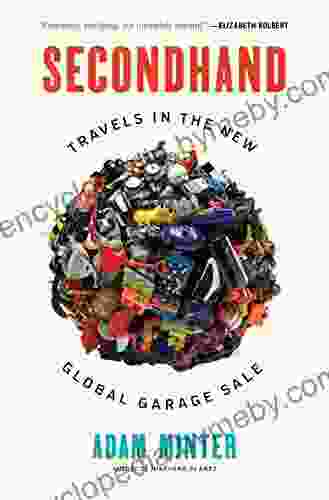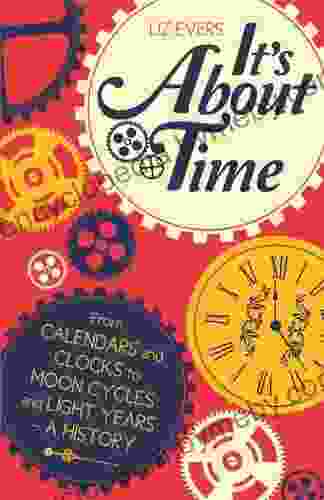From Calendars and Clocks to Moon Cycles and Light Years: A History of Timekeeping

Time is one of the most fundamental concepts in human experience. We use it to measure our lives, plan our days, and make sense of the world around us. But how did we come to understand time in the first place? And how have we developed the tools to measure and track it?
4.6 out of 5
| Language | : | English |
| File size | : | 2470 KB |
| Text-to-Speech | : | Enabled |
| Screen Reader | : | Supported |
| Enhanced typesetting | : | Enabled |
| Print length | : | 225 pages |
This book is a comprehensive history of timekeeping, from the earliest calendars and clocks to the latest atomic clocks. It explores the development of timekeeping technology and its impact on human civilization.
Chapter 1: The Earliest Calendars
The earliest calendars were based on the observation of the sun and moon. People noticed that the days grew shorter and longer throughout the year, and that the moon went through a cycle of phases. By tracking these cycles, people were able to create calendars that could predict the changing seasons and the coming of special events.
The first known calendars were developed in Mesopotamia around 3000 BC. These calendars were based on a 12-month year, with each month consisting of 30 days. The months were named after the constellations that were visible in the sky during that time of year.
Other early calendars were developed in Egypt, China, and India. These calendars were all based on different astronomical observations, but they all served the same purpose: to help people keep track of time.
Chapter 2: The Invention of Clocks
The invention of clocks was a major breakthrough in the history of timekeeping. Clocks allowed people to measure time more accurately than ever before. This had a profound impact on human civilization, as it made it possible to schedule events, coordinate activities, and measure the passage of time.
The first mechanical clocks were invented in the 14th century. These clocks were large and inaccurate, but they were still a significant improvement over the sundials and water clocks that had been used previously.
Over the centuries, clocks became smaller, more accurate, and more affordable. This made them increasingly available to the general population. By the 19th century, clocks were a common sight in homes and businesses around the world.
Chapter 3: Moon Cycles and Light Years
In addition to calendars and clocks, people have also used moon cycles and light years to measure time.
The moon cycle is the period of time it takes for the moon to orbit the Earth. This cycle is about 29.5 days long. People have used the moon cycle to track time for centuries.
Light years are a measure of distance, not time. However, they can be used to measure time indirectly. One light year is the distance that light travels in one year. This distance is about 9.46 trillion kilometers.
Astronomers use light years to measure the distances to stars and galaxies. By measuring the distance to a star, astronomers can calculate how long it took the light from that star to reach Earth. This information can be used to estimate the age of the star and the universe itself.
Chapter 4: The Impact of Timekeeping on Human Civilization
The development of timekeeping technology has had a profound impact on human civilization. Calendars and clocks have made it possible for us to plan our lives, coordinate our activities, and measure the passage of time.
Timekeeping technology has also played a major role in the development of science and technology. Clocks have been used to measure the speed of light, the distance to the stars, and the age of the universe.
Today, timekeeping technology is more important than ever before. We rely on clocks to schedule our lives, operate our businesses, and navigate the world around us. Timekeeping technology is essential to our modern way of life.
Timekeeping is one of the most fundamental aspects of human experience. We use it to measure our lives, plan our days, and make sense of the world around us. The development of timekeeping technology has had a profound impact on human civilization. Calendars and clocks have made it possible for us to plan our lives, coordinate our activities, and measure the passage of time. Timekeeping technology has also played a major role in the development of science and technology. Today, timekeeping technology is more important than ever before. We rely on clocks to schedule our lives, operate our businesses, and navigate the world around us. Timekeeping technology is essential to our modern way of life.
4.6 out of 5
| Language | : | English |
| File size | : | 2470 KB |
| Text-to-Speech | : | Enabled |
| Screen Reader | : | Supported |
| Enhanced typesetting | : | Enabled |
| Print length | : | 225 pages |
Do you want to contribute by writing guest posts on this blog?
Please contact us and send us a resume of previous articles that you have written.
 Book
Book Novel
Novel Page
Page Chapter
Chapter Text
Text Story
Story Genre
Genre Reader
Reader Library
Library Paperback
Paperback E-book
E-book Magazine
Magazine Newspaper
Newspaper Paragraph
Paragraph Sentence
Sentence Bookmark
Bookmark Shelf
Shelf Glossary
Glossary Bibliography
Bibliography Foreword
Foreword Preface
Preface Synopsis
Synopsis Annotation
Annotation Footnote
Footnote Manuscript
Manuscript Scroll
Scroll Codex
Codex Tome
Tome Bestseller
Bestseller Classics
Classics Library card
Library card Narrative
Narrative Biography
Biography Autobiography
Autobiography Memoir
Memoir Reference
Reference Encyclopedia
Encyclopedia Jane Gross
Jane Gross A L Dawn French
A L Dawn French Chris Irons
Chris Irons Bill Karwin
Bill Karwin Roger Stelljes
Roger Stelljes Abdul El Sayed
Abdul El Sayed 17th Edition Kindle Edition
17th Edition Kindle Edition 2010th Edition Kindle Edition
2010th Edition Kindle Edition Thad Beery
Thad Beery Bobby Orr
Bobby Orr Jacques Devore
Jacques Devore A L Long
A L Long D Levesque
D Levesque Marina Jarre
Marina Jarre Abdel Bari Atwan
Abdel Bari Atwan Sherry Ginn
Sherry Ginn Abbey Cristy
Abbey Cristy Keith O Neil
Keith O Neil Lily Collison
Lily Collison Dr Tracy Sanders
Dr Tracy Sanders
Light bulbAdvertise smarter! Our strategic ad space ensures maximum exposure. Reserve your spot today!

 Ismael HayesNative Women of Courage: Honoring the Strength and Resilience of Indigenous...
Ismael HayesNative Women of Courage: Honoring the Strength and Resilience of Indigenous...
 Jerome BlairThe History of Havana Dick Cluster: A Pirate's Paradise and a Window into the...
Jerome BlairThe History of Havana Dick Cluster: A Pirate's Paradise and a Window into the...
 Banana YoshimotoUnlock Your SAT Reading Potential: The Ultimate Guide to Advanced Practice
Banana YoshimotoUnlock Your SAT Reading Potential: The Ultimate Guide to Advanced Practice
 Geoffrey BlairConversations With Winemakers: Unraveling the Enchanting World of Mendoza,...
Geoffrey BlairConversations With Winemakers: Unraveling the Enchanting World of Mendoza,... Cormac McCarthyFollow ·5.2k
Cormac McCarthyFollow ·5.2k Richard SimmonsFollow ·16.1k
Richard SimmonsFollow ·16.1k Sam CarterFollow ·12.6k
Sam CarterFollow ·12.6k Charlie ScottFollow ·13.7k
Charlie ScottFollow ·13.7k Doug PriceFollow ·7.3k
Doug PriceFollow ·7.3k Trevor BellFollow ·9k
Trevor BellFollow ·9k Raymond ChandlerFollow ·16.8k
Raymond ChandlerFollow ·16.8k Lawrence BellFollow ·13.5k
Lawrence BellFollow ·13.5k

 Timothy Ward
Timothy WardFearless Painting for True Beginners: Learn to Create...
Unlock the Joy of...

 Fernando Pessoa
Fernando PessoaProven 12-Step Program for Financial Peace of Mind:...
Are you struggling with...

 Chinua Achebe
Chinua AchebeLayers Colors Desire: Layers Colors Thoughts Mystery
A Literary Labyrinth...

 Fernando Bell
Fernando BellUnearth Hidden Treasures: Journey Through "Secondhand...
Prepare to embark on an extraordinary...

 Caleb Carter
Caleb CarterSymbolic Messages Garage Sale Mysteries: Unveiling the...
Welcome to the extraordinary world of the...

 Nikolai Gogol
Nikolai GogolTravels in the Billion Dollar Trash Trade: Uncovering the...
Ỡ In his...
4.6 out of 5
| Language | : | English |
| File size | : | 2470 KB |
| Text-to-Speech | : | Enabled |
| Screen Reader | : | Supported |
| Enhanced typesetting | : | Enabled |
| Print length | : | 225 pages |




